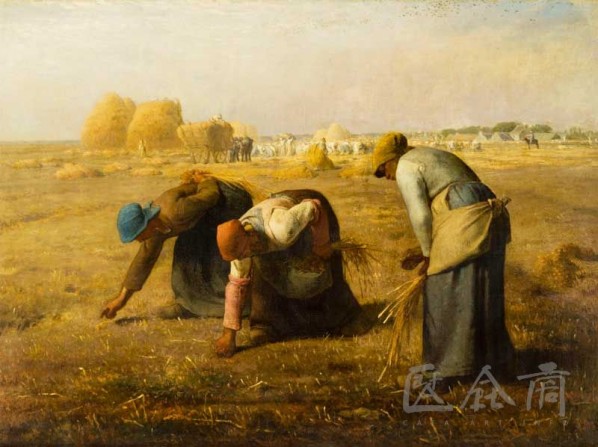
Nearly a decade after the immense success of the 2004-2005 Impressionist Treasures exhibition, the Musée d’Orsay is back in Shanghai to present the first major exhibition in the newly-opened China Art Museum inaugurated on 1 October and housed in what used to be the Chinese Pavilion of the 2010 World Fair. Millet, Courbet and French Naturalism features 87 masterpieces on loan from Musée d’Orsay in Paris, France. Also on display will be paintings by Corot, Bonheur, Lepage, Roll, Renoir, and the Barbizon painters, all exploring the interplay between art, nature and societal changes in the late 19th and early 20th century. One of the highlights of the exhibition is Millet’s “The Gleaners”, which depicts three women searching for wheat after the harvest.
Alongside Millet and Courbet, all the major protagonists of these pictorial movements are represented: Jules Bastien-Lepage, Alfred Roll, Rosa Bonheur, as well as the painters of the Ecole de Barbizon, including Corot…, artists who broke free from contemporary academic rules to deliver a new vision of nature, but also to represent the men around them, the traditions and also the profound mutations of a fast-changing society.
According to the report by Agence France-Presse, the exhibition will return to France next year in time for an October showing at the Musee d’Orsay, said Olivier Simmat, the museum’s head of international affairs.
[gallery link="file" order="DESC" orderby="title"]
Introduction of all the chapters in this exhibition
The exhibition is generally arranged in chronological order. It starts from the bud and the beginning of French Naturalism (Barbizon, Corot) - critical turning point (Courbet) - a typical representative (Miller) - development (realism) - change and the impact (changes of thematic and content).
Chapter 1: “Landscape: From Corot to Courbet”. The show starts from Corot and the Barbizon School, compared with Courbet’s oil paintings of landscape and still life, embodying a notable feature of “Naturalism” with the emphasize on describing real objects.
Chapter 2: “Miller”. Miller’s works have a relative prominent style, the objects and painting content is relatively pure (pastoral scenery and busy farms), and therefore there is a unique chapter, especially as there is the first profound portrayal of a group of farmers, in line with the objective reality, as well as full of poetry.
Chapter 3: “Realism”. Taking Courbet as the beginning, it depicts real scenes and ordinary objects on the two aspects of art theory and painting practice. Different from the above two chapters, the artists that featured in this part begin to focus on the contact and expression of relationships between humans and the natural environment: avoiding the scenic style, while displaying real life. Referring to the colors of works, it is the continuation of Miller’s style, highlighting their different levels of paintings with similar colors.
Chapter 4: “Naturalism”. This chapter could be seen as poetic “realism”. The majority of the paintings describe laborious scenes in the wild. When artists face real scenes, they give them a poetic style, meanwhile, with the use of a fabulous painting skill that is close to photography, with the crisper and brighter tones, the rich and lively colors, and focus on the performance of a relaxed and natural picture.
Chapter 5: “Painter ‘Butterfly Dream’”. This part is the combination of tradition and innovation. On the one hand, it is impossible that the long history and traditional techniques of portrait creations cannot be completely abandoned in the new era, and on the other hand, naturalism and realism have created a significant impact on the development of portrait painting. All the characters of the paintings are artists’ friends, and even artists themselves.
Chapter 6: “The Bourgeoisie of a Low-Key Charm.” The chapter features portrait and figure paintings by different schools in the period from the late 19th century to the early 20th century, displaying the interactions and lessons from each other between “Naturalism” and the paintings, as well as drawing the characters (especially aesthetic of the middle class) of the times in a realist style.
Chapter 7: “Children”. In the late 19th century, along with the progress of society, the state’s increasing concern with a group of children, and even more prohibiting child labor through the establishment of new legislation. At the same time, taking the style of “naturalism” into account, it plans and selects the works in the theme of “Children”, the screen is full of emotion, lively and funny.
Chapter 8: “Giving a Rallying Cry to the Sufferings of the Common People.” This is a breakthrough, and is the ending chapter of rich contemporary spirits. In accordance with the customary understanding and awareness of people, “Naturalism" is often considered to be mainly expressive of rural life and the countryside, and the natural and relaxed style is separated from heavy reality. Under the background of the change of times, especially in the eve of World War I, there was an accumulation of social contradictions in France, and artists inevitably joined and participated in a series of changes, for example: firstly, there is a realistic record of social (political and economic) transformation, secondly, there is a sublimation of “naturalism” and “realism” in the range of art, thirdly, the awareness of human beings (awareness of different social strata).
About the exhibition
Date: 16 November 2012 – 28 February 2013
Venue: Shanghai, China Art Museum
Address: 161 Shang nan Road, Pudong District, Shanghai
Curators:
Stéphane Guégan, curator at the Musée d’Orsay
Xavier Rey, curator at the Musée d’Orsay
Exhibition organised by the China Art Museum, Shanghai and the Musée d’Orsay, Paris.
Courtesy of China Art Museum, Shanghai and the Musée d’Orsay, Paris, for further information please visit www.musee-orsay.fr/en.




























